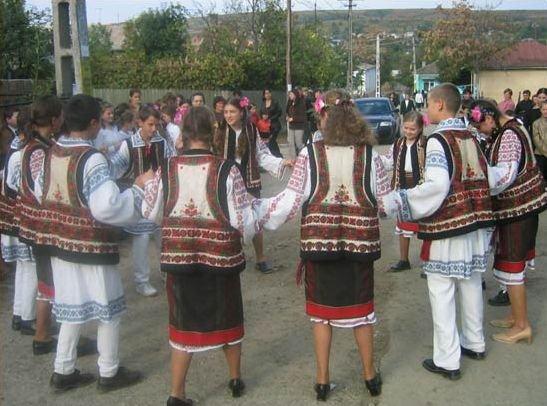A Sunday dance,
hora in Romanian, with the
participation of all local classes, on
the village green sometime in late 1890s
in Southern Romania. (Old postcard - Valentin
Mandache collection)
The picture
on the old postcard above shows a typical
village green from the lower Danube plain
region of Romania at the turn of the 19th
century to the 20th century. The scene is
that of a Sunday dance, or hora in
Romanian, an energetic round dance where
eligible young peasant men and women met
and danced together in their Sunday
best (clothes made of homespun cloth,
richly embroidered with ethnic motifs).
The custom is still preserved in many of
Romaniaís villages, especially in the more
isolated mountain communities. The
Sunday dance was a very important village
event, even more important than the church
service in which the local landlord also
often participated together with the
estate administrator and their families.
On the left side of the photograph above,
we can see a covered horse carriage, which
most probably belonged to the local land
owner, the boyar, the wealthiest
local, who came from his nearby country
mansion, or conac.
Next to it, there is another somewhat more
modest carriage which probably belonged to
the estate administrator, the arendas
in Romanian, and further to the
right is another really modest horse drawn
carriage which probably belonged to one of
the local state officials like the teacher
or policeman. In the middle of the round
dance, the orchestra plays. It was usually
a gypsy band comprised of musicians from
the local gypsy community, descendants of
the former estate slaves, an ethnic group
that was freed by the state only in the
mid 19th century, after half
of millennium of slavery. They
are playing the instruments common to this
region like a portable zimbalon,
violin and lute, etc. On the right side of
the photograph, there are two ladies in
the town dress of the 19th century who
keep a formal distance from the peasants;
they are presumably members of the
landlordís family. There are, however,
some people in the crowd in town dress
that mingle happily with the
peasants. The village green
is surrounded by
an assortment of peasant houses,
in the foreground two modest, basic
houses with thatched roofs, typical of
very poor peasant families. Next, on their
right is the
fence surrounded courtyard of a
wealthier peasant with a better house
with a shingle covered roof. The
photograph offers a wonderful glimpse into
a happy moment in the life of a Romanian
village at the height of
the Victorian era. It is also a
useful record of the time giving insight
into that the psychology and way of life
of the Romanian peasants for anyone
interested in visiting these areas or
buying a traditional house there.
|

